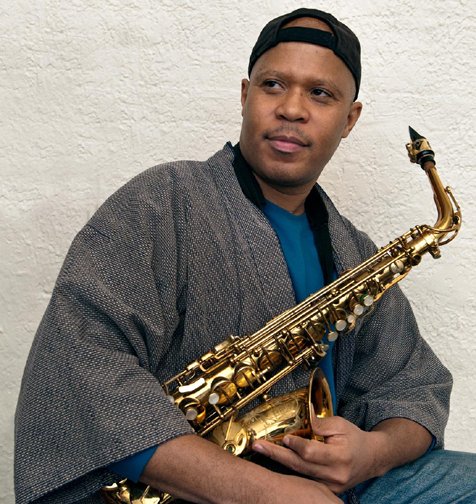Metaphysical Phunktion
Steve Coleman and Five Elements: Steve Coleman (alto sax, vocals, backing vocals), Graham Haynes (trumpet), Kelvyn Bell (electric guitar, vocals), Geri Allen (synthesizer), Kevin Bruce Harris (electric bass, backing vocals), Mark Johnson (drums, percussion), Marvin “Smitty” Smith (drums, percussion, backing vocals) and Cassandra Wilson (vocals, backing vocals). From the album On the Edge of Tomorrow (1986).
In 1991, numerous M-Base participants who had previously contributed with Coleman formed the M-Base Collective and recorded Anatomy of a Groove. Later, since the M-Base style was incompatible with the music industry, most of the members of the movement began to perform more conventional music. In search of the roots of black culture, in 1993 Coleman visited Ghana, where he met the Dagomba people, whose traditional drum music uses a very complex polyrhythm. He collaborated with musicians interested in traditions from West Africa and approached the Yoruba religion, one of the oldest in Africa.

Then he went to Cuba, where he made contact with the group Afrocuba de Matanzas, specialized in preserving African traditions, such as the Arara, the Abakua, the Congo and the Yoruba itself, which mixed are called Santeria, and several styles of rumba. In 1998 he took his group Steve Coleman and Five Elements to South India to learn about carnatic music. He also created the group Renegade Way with which he toured Europe and for some time he was a record producer. In 2010 he joined Pi Recordings, whose first three albums were highly praised, and has continued recording with this label to this day.

The first thing that sounds is a gong followed by music that seems to originate from the Middle East, but then becomes funky with the predominance of the electric bass line. After that Coleman and Haynes enter playing in unison an uncommon and unusual speech, and then Bell sings a tune following the rest of the group, but introducing hip hop elements. Then the music from the Middle East returns to give way to Coleman, who offers a well-built and precise solo. Next the group plays a sound baseline on which Haynes later presents an elaborate and slightly adventurous discourse. Then the music from the Middle East comes back to introduce Bell, who produces with his guitar a singular sound thanks to the pedals and whose improvisation comes close to jazz fusion, but with his own identity, and which little by little fades out.
